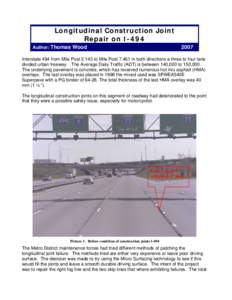Displaying results 1 - 24 of 24
Minnesota Seal Coat Handbook 2006
Date Created
2006
Report Number
2006-34
Description
Cost-Effective Pavement Preservation Solutions for the Real World
Date Created
2014
Report Number
2014-33
Description
Research Using Waste Shingles for Stabilization or Dust Control for Gravel Roads and Shoulders
Date Created
2014
Report Number
2014-06
Description
Preventive Maintenance for Recreational Trails
Date Created
2009
Report Number
2009-25
Description
Preventive Maintenance Best Management Practices of Hot Mix Asphalt Pavements
Date Created
2009
Report Number
2009-18
Description
Long Term Maintenance Effects on HMA Pavements Caused by Rumble Strips and Available Preventive Treatment Methods
Date Created
2008
Report Number
2008-50
Description
Minnesota Seal Coat Handbook 2021
Date Created
2021-03
Description
Minnesota Seal Coat Handbook 2022
Date Created
2022-12
Report Number
2022-22
Description
Concrete Pavement Restoration for Bonded Concrete Overlay of Asphalt Synthesis
Date Created
2020
Report Number
NRRA202001
Description
Asphalt Mix Rejuvenators Synthesis
Date Created
2020
Report Number
NRRA202002
Description
Service Life Enhancement of Substrates Overlaid with Thin Overlays (UTBWC, Chip Seals, and Micro-Surfacing)
Date Created
2020
Report Number
NRRA202003
Description
Spray on Rejuvenator Synthesis
Date Created
2020
Report Number
NRRA202004
Description
























